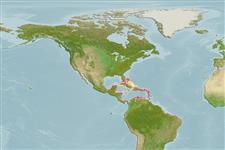Common names from other countries
Classification / Names / Names
Common names | Synonyms | Catalog of Fishes (gen., sp.) | ITIS | CoL | WoRMS
Environment: milieu / climate zone / depth range / distribution range
Ecology
Benthic; depth range 0 - 1 m (Ref. 2022). Tropical
Western Central Atlantic.
Length at first maturity / Size / Weight / Age
Maturity: Lm ? range ? - ? cm Max length : 5.1 cm TL male/unsexed; (Ref. 281)
Body: Oblong; slightly beaked mucro. Valve: Surface, commonly eroded from the habitat; whitish grey with blue-green to moss-green mottlings on the sides; surface is roughly sculptured. Lateral areas: Bordered anteriorly and posteriorly by a large, rugose rib. Central areas: Low, rough, longitudinal ribs. Girdle: Leathery, yellowish-brown and with numerous yellowish-brown clusters of strap like hairs (Ref. 281).
Intertidal, rocky shore (Ref. 2022). Epibiotic (Ref. 110502).
Life cycle and mating behavior
Maturity | Reproduction | Spawning | Eggs | Fecundity | Larvae
Members of the class Polyplacophora are mostly gonochoric. Life cycle: Eggs hatch into lecitotrophic planktonic trocophore larvae (no veliger stage) which later metamorphose and settle on the bottom as young adults.
Burghardt, G. and L. Burghardt. 2006. (Ref. 281)
IUCN Red List Status (Ref. 130435)
CITES status (Ref. 108899)
Not Evaluated
Not Evaluated
Human uses
| FishSource |
Tools
More information
Age/SizeGrowthLength-weightLength-lengthMorphologyLarvaeAbundance
Internet sources
Estimates based on models
Preferred temperature
(Ref.
115969): 26.1 - 28.3, mean 27.3 (based on 331 cells).
Vulnerability
Low vulnerability (10 of 100).
Price category
Unknown.
